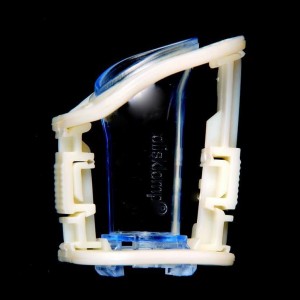What is Alisklamp?
Alisklamp is the most advanced circumcision device, which was developed by Urology Specialist Surgeon Vedat Ali Canoğlu in 2000 and has been used successfully in many countries of the world, with more than 15 scientific studies about it and the subject of thesis in University hospitals.
 The Alisklamp method is a circumcision technique that is widely used in recent years and is based on first clamping the foreskin to be cut with a plastic clamp and then cutting it. Since the plastic clamp holds the foreskin tightly, there is no risk of bleeding when cutting. The principle of clamping and then cutting the tissues with the plastic Alisklamp clamp has been used for years when cutting the umbilical cord of babies. When cutting the newborn baby’s cord, no sutures are used anymore, but instead the cord is attached with a plastic buckle-like clip and then cut. The plastic clamp used in circumcision can be defined as the round shape of the clip applied to the umbilical cord adapted to the penis. I would like to point out that this method is completely compatible with surgical principles. The goal here is to hold the cut wound lips together. Today, there are many materials used as an alternative to sewing to achieve this goal. For example, sterile tapes (sterile strips) are used instead of sutures in head cuts. Wound ends brought together with the help of these bands heal in 4-5 days. Staples are used to close long wounds in major surgeries, and fibrin glue is used for short wounds. The only task of these materials, which are used as an alternative to suture, is to bring the wound edges to the end and keep them in this position for a while. The only task of the plastic clamp is to hold the wound lips together. All materials such as sutures, steel staples, sterile tape, tissue glue or plastic clips are just tools to close wounds. The aim is to bring the wound ends together without harming the body. The most suitable material for circumcision for this purpose seems to be the plastic clamp until a more suitable one is discovered.
The Alisklamp method is a circumcision technique that is widely used in recent years and is based on first clamping the foreskin to be cut with a plastic clamp and then cutting it. Since the plastic clamp holds the foreskin tightly, there is no risk of bleeding when cutting. The principle of clamping and then cutting the tissues with the plastic Alisklamp clamp has been used for years when cutting the umbilical cord of babies. When cutting the newborn baby’s cord, no sutures are used anymore, but instead the cord is attached with a plastic buckle-like clip and then cut. The plastic clamp used in circumcision can be defined as the round shape of the clip applied to the umbilical cord adapted to the penis. I would like to point out that this method is completely compatible with surgical principles. The goal here is to hold the cut wound lips together. Today, there are many materials used as an alternative to sewing to achieve this goal. For example, sterile tapes (sterile strips) are used instead of sutures in head cuts. Wound ends brought together with the help of these bands heal in 4-5 days. Staples are used to close long wounds in major surgeries, and fibrin glue is used for short wounds. The only task of these materials, which are used as an alternative to suture, is to bring the wound edges to the end and keep them in this position for a while. The only task of the plastic clamp is to hold the wound lips together. All materials such as sutures, steel staples, sterile tape, tissue glue or plastic clips are just tools to close wounds. The aim is to bring the wound ends together without harming the body. The most suitable material for circumcision for this purpose seems to be the plastic clamp until a more suitable one is discovered.
The history of circumcision technique with plastic clamp dates back 150 years. Years ago, the foreskin was cut with a metallic clip. In the 1990s, when I was a urology assistant at Ankara University, we were performing the circumcision of newborn babies with a bell-shaped metal clamp called “gomko”. I would also like to point out that during my internship years, blood was drawn with glass syringes used by boiling. With the development of plastic technology, disposable plastic equivalents of many medical materials have been produced. For example, plastic disposable injectors have been used in our country for the last 20 years. Likewise, a single-use plastic version of the gomko device was produced.
Disposable (single-use) plastic grippers came into use in Europe and the USA about 20 years ago, and in our country for more than 20 years. Nowadays, these disposable plastic clips are used instead of metallic clips, namely gomko. These plastic clips can only be used once and are available in sterile packages. Firstly, plastic clamps produced by a Dutch company and made in Singapore were used in our country, but in recent years, domestically produced plastic clamps with CE certificate have also been put into use. Plastic clamps start at 10 and grow up to 18, depending on the size of the child’s penis. During the circumcision, each child is chosen the appropriate number for his penis. The plastic clamp consists of two parts. The first part consists of a transparent funnel-like piece of plastic about 2cm long with an empty inside. The second part consists of a white, circular plastic with a locking mechanism.



